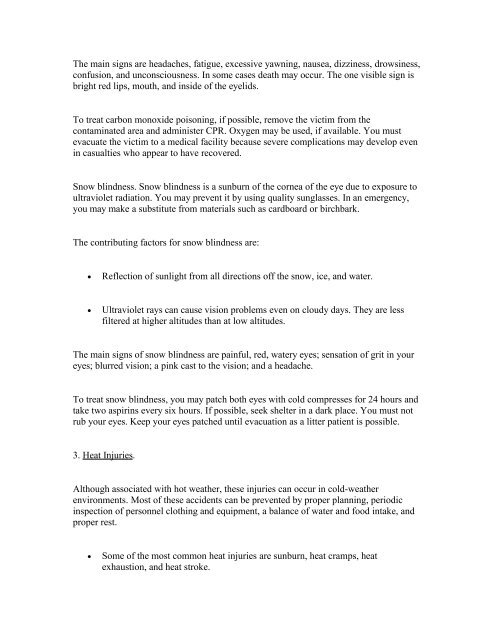US Army mountaineering techniques (basic)
US Army mountaineering techniques (basic)
US Army mountaineering techniques (basic)
Create successful ePaper yourself
Turn your PDF publications into a flip-book with our unique Google optimized e-Paper software.
The main signs are headaches, fatigue, excessive yawning, nausea, dizziness, drowsiness,<br />
confusion, and unconsciousness. In some cases death may occur. The one visible sign is<br />
bright red lips, mouth, and inside of the eyelids.<br />
To treat carbon monoxide poisoning, if possible, remove the victim from the<br />
contaminated area and administer CPR. Oxygen may be used, if available. You must<br />
evacuate the victim to a medical facility because severe complications may develop even<br />
in casualties who appear to have recovered.<br />
Snow blindness. Snow blindness is a sunburn of the cornea of the eye due to exposure to<br />
ultraviolet radiation. You may prevent it by using quality sunglasses. In an emergency,<br />
you may make a substitute from materials such as cardboard or birchbark.<br />
The contributing factors for snow blindness are:<br />
Reflection of sunlight from all directions off the snow, ice, and water.<br />
Ultraviolet rays can cause vision problems even on cloudy days. They are less<br />
filtered at higher altitudes than at low altitudes.<br />
The main signs of snow blindness are painful, red, watery eyes; sensation of grit in your<br />
eyes; blurred vision; a pink cast to the vision; and a headache.<br />
To treat snow blindness, you may patch both eyes with cold compresses for 24 hours and<br />
take two aspirins every six hours. If possible, seek shelter in a dark place. You must not<br />
rub your eyes. Keep your eyes patched until evacuation as a litter patient is possible.<br />
3. Heat Injuries.<br />
Although associated with hot weather, these injuries can occur in cold-weather<br />
environments. Most of these accidents can be prevented by proper planning, periodic<br />
inspection of personnel clothing and equipment, a balance of water and food intake, and<br />
proper rest.<br />
Some of the most common heat injuries are sunburn, heat cramps, heat<br />
exhaustion, and heat stroke.

















